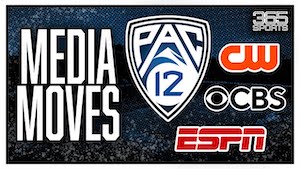
By SuperWest Sports Staff
May 6, 2025
After months of legal battles and regrouping, Oregon State and Washington State have made substantial progress in rebuilding the Pac-12.
After adding Boise State, Colorado State, Fresno State, San Diego State, Utah State, and Gonzaga as new members, the Conference inked media deals with ESPN, CBS, and The CW for the 2025 football season.
The rebuilding Pac-12 must still add one more school by 2026 to retain its status as a conference in good standing.
The Conference also remains embroiled in a legal dispute with the Mountain West Conference over a “poaching fee” and team exit fees, which the MW claims it is owed. That dispute appears headed for mediation.
How will the Pac-12 fare going forward?
Time will tell, but adding six quality schools and signing an impressive media deal for 2025 has the Conference off to a propitious start.
Here’s an updated timeline for the Conference of Champions from its inception in 1915 through its latest progress.
The bullet-point summary tracks the major events in the Pac-12’s formation, expansion, realignment, collapse, and rebirth.
1915
The Conference is founded as the Pacific Coast Conference (PCC) at a meeting at the Imperial Hotel in Portland, Oregon. The charter members were California, Washington, Oregon, and Oregon State.

1916
The PCC begins play and the Conference begins hosting the annual Rose Bowl.
1917
Washington State joins the league.
1918
Stanford is added.
1922
The PCC expands to eight teams with the admission of USC and Idaho.
1924
Montana joins the Conference.

1928
The PCC grows to 10 members with the addition of UCLA.
1938
The Conference hires former FBI agent Edwin Atherton as its Commissioner.
1947
The champion of the Big Ten becomes the designated Rose Bowl opponent for the Pac-12 Champion.
1950
Montana departs to join the Mountain States Conference.
1958
California, USC, UCLA, and Washington become embroiled in “pay-for-play” scandals.
1959
The 1958 scandals lead PCC to disband; California, USC, UCLA, and Washington form a new conference called the Athletic Association of Western Universities (AAWU) with athletics administrator Tomas J. Hamilton as its commissioner. Stanford is added a month later.
1962
Washington State joins the Conference, which informally becomes known as the Big Six.
1964
Oregon and Oregon State are added and the conference is known unofficially as the Pacific Athletic Conference, though still officially the AAWU.
1968
The Conference formally renames itself the Pacific-8 Conference, or Pac-8 for short.
1975
Pac-8, now based in Walnut Creek, Calif., allows a second bowl team from the Conference
1978
The Conference adds Arizona and Arizona State from the Western Athletic Conference, becoming the Pacific-10 Conference or Pac-10.
1983
The Pac-10 hires long-time conference executive Thomas C. Hansen as Commissioner.
2002
The Conference’s exclusive arrangement with the Rose Bowl ends when the bowl hosts the national championship game in the Bowl Championship Series (BCS).

2009
Tom Hansen retires as the longest-tenured Division-I conference commissioner in the country, and the Pac-10 hires Larry Scott, the former head of the Women’s Tennis Association, to replace him.
2010
Pac-10 considers adding up to six teams to the Conference from among Texas, Texas A&M, Texas Tech, Oklahoma, Oklahoma State, and Colorado. The Buffaloes and Utah are extended invitations and both agree to join.
2011
The Conference is renamed the Pac-12, and former Big 12 school Colorado and former WAC school Utah begin play. To accommodate them, the Conference is divided into South and North divisions.
2012
The Conference debuts the Pac-12 Network, only the third dedicated network in the nation, and the first to completely fund and own its own network outright.
2014
The Pac-12 relocates from Walnut Creek to San Francisco.

2021
Larry Scott’s tenure as commissioner ends. George Kliavkoff, the former president of entertainment and sports for MGM Resorts International is hired to take his place. Soon after, the Pac-12, ACC, and Big Ten announced the formation of a nonbinding “historic alliance.”
2022
— USC and UCLA announce their departure from the Pac-12 to the Big Ten Conference beginning with the 2024–25 academic year.
— Reports began circulating that Commissioner Kliavkoff had visited San Diego State University and SMU campuses for tours. This was allegedly part of the conference’s vetting process for expansion.
— San Diego State sent the Mountain West Conference a letter notifying them of their impending departure. The Pac-12, however, was adamant about securing a media rights deal before expanding.
— Without an incoming offer before a June 30, 2023 deadline, San Diego State had to rescind its intention to leave the Mountain West.
2023
— Colorado announces its return to the Big 12 on July 27.
— On August 4, Oregon and Washington announce that they will be following UCLA and USC to the Big Ten conference for the 2024 season.
— Later that day, Arizona, Arizona State, and Utah announce that they will be leaving for the Big 12 Conference starting in 2024.
— On September 1, the ACC presidents and chancellors vote to add Stanford and Cal (along with SMU) beginning in 2024.

— On September 11th, Washington State and Oregon State take the Pac-12 and Commissioner George Kliavkoff to court in Whitman County, Washington, obtaining a temporary restraining order blocking the Conference’s 10 departing schools from holding a meeting and a potential vote of their presidents.
— On November 14, Judge Gary Libey of the Whitman County, Washington Superior Court rules in favor of the two schools. The University of Washington (UW) files an emergency motion to keep the two schools from gaining full control of the conference for the 2023-24 academic year
— A Washington Supreme Court commissioner grants UW’s motion on November 28.
— The motion is overturned on December 15 by the Washington State Supreme Court, giving Oregon State and Washington State sole control of the Pac-12. The decision prevents the departing schools from voting on conference matters.
— On December 5, 2023, Oregon State and Washington State announces that they have entered into a football alliance with the Mountain West Conference for the 2024 season to play three home games and three away games against MWC opponents.
— The West Coast Conference (WCC) invites both teams as affiliate members for basketball and most other non-football sports. Both partnerships are expected to last from the fall of 2024 to the spring of 2026.
— The remaining two conference members announce plans to continue using the Pac-12 name and branding for at least the 2024–25 academic year.
2024
— On February 19, the Pac-12 Board of Directors announces Teresa Gould as the first woman commissioner of a then-Power Conference to replace Kliavkoff, effective March 1.
— Soon after, Kliavkoff unfollows nearly everyone associated with his time as Pac-12 Commissioner and changes his X/Twitter bio to read “Fishing…”

— In early May, Washington State and Oregon State universities sign football TV deals with The CW and Fox.
— In June, the Pac-12 Network announces that programming would only be available through the last weekend of the last weekend of the month.
— On July 21, the Conference holds an intimate and unusual two-team media day in Las Vegas billed as “After Hours with the Beavs & Cougs.”

— On September 12th, the Conference announced the addition of four new member schools: Boise State, Colorado State, Fresno State, and San Diego State, all from the Mountain West, beginning with the 2026 season.
— On September 24, the Pac-12 adds Utah State, bringing their total football membership to seven. That same day, the Conference files a federal lawsuit against the Mountain West Conference, claiming that its $55 million “poaching penalties are unlawful and unenforceable.”
— On September 30, Gonzaga joins the Conference as a full member, even though they do not play football.
— In November, the Mountain West files a motion to dismiss the lawsuit filed by the Pac-12.
— On December 16, Colorado State and Utah State file a separate lawsuit against the Mountain West over their exit fees.
— On December 18, Boise State joins the lawsuit filed by CSU and Utah State.
2025
—On February 27, the Mountain West and the Pac-12 agree to informal mediation, along with Boise State, Colorado State, and Utah State, in the hope of settling the ongoing lawsuits among them.
— On March 14, both conferences agree to a 60-day stay of their case issued by a federal judge in the Northern District of California, issued a stay order, which would end on May 16, to discuss mediation options.
— On April 28, the Pac-12 announces its television partnerships for the 2025 football season, with The CW, ESPN, and CBS combining to show the 13 home games involving Oregon State and Washington State.


